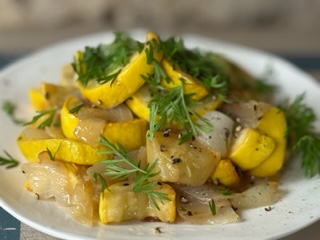March 23, 2024
Early last fall I planted a 4” pot of caraway in my raised garden bed. That little plant has now more than tripled in size.
Just a few days ago tiny white flowers appeared atop the feathery foliage. Blooming should continue until sometime during late spring or early summer when spent flowers yield those small, but wonderfully aromatic, hard brown seeds used in cuisines throughout the world.
If you’ve never grown caraway in your garden, follow along as we learn more about this carrot-like plant which is edible from root to shoot!
Caraway is a hardy herbaceous biennial requiring two seasons to complete its life cycle. The first year, bright green threadlike foliage resembling that of a carrot form a mound 1 to 3 feet high. Next comes the umbels of creamy white, delicate flowers that resemble Queen Anne’s Lace.
Once the flowers are spent, brown ribbed seeds appear. The familiar caraway seed is actually the fruit of the plant. It is recommended that seeds should be harvested about a month after they have blossomed. To accomplish this, clip off the seed heads and place in a paper bag to finish ripening.
While caraway seeds are most often associated with rye (or dark rye) breads there are a many other applications for using it. Some include: desserts and baked goods, liquors, stews, casseroles and as a flavoring for beef and pork dishes.
When the plant has produced seed, dig up the taproot and use as you would any other root vegetable.
Caraway is a pleasing plant to grow in your herb garden. The lovely little flowers attract beneficial insects, including honeybees.
For two different dinner options recently, we enjoyed caraway leaves straight from the garden in the following ways:


Linda Alexander, Dallas County Master Gardner Class of 2008


